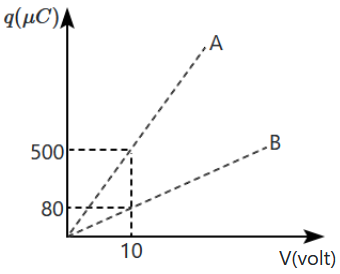When a particle with charge \(+q\) is thrown with an initial velocity \(v\) towards another stationary change \(+Q,\) it is repelled back after reaching the nearest distance \(r\) from \(+Q.\) The closest distance that it can reach if it is thrown with an initial velocity \(2v,\) is:
1.
\(\frac{r}{4}\)
2.
\(\frac{r}{2}\)
3.
\(\frac{r}{16}\)
4.
\(\frac{r}{8}\)
| Assertion (A): | A metallic shield in the form of a hollow shell may be built to block an electric field. |
| Reason (R): | In a hollow spherical shield, the electric field inside it is zero at every point. |
| 1. | Both (A) and (R) are true and (R) is the correct explanation of (A). |
| 2. | Both (A) and (R) are true but (R) is not the correct explanation of (A). |
| 3. | (A) is true but (R) is false. |
| 4. | (A) is false but (R) is true. |
| A: | Free electrons move always from a region of higher potential to a region of lower potential. |
| B: | The capacitance of the capacitor does not depend upon the nature of the conducting material of the plates of the capacitor. |
| 1. | only A |
| 2. | only B |
| 3. | both A and B |
| 4. | neither A and B |
| Assertion (A): | Charge on an insolated capacitor does not change by introducing dielectric between the plates of the capacitor. |
| Reason (R): | Charge on an isolated system is conserved. |
In the light of the above statements choose the correct answer from the options given below:
| 1. | Both (A) and (R) are true and (R) is the correct explanation of (A). |
| 2. | Both (A) and (R) are true but (R) is not the correct explanation of (A). |
| 3. | (A) is true but (R) is false. |
| 4. | (A) is false but (R) is true. |

1. \(50\) \(\mu F\) and \(30\) \(\mu F\)
2. \(20\) \(\mu F\) and \(30\) \(\mu F\)
3. \(60\) \(\mu F\) and \(40\) \(\mu F\)
4. \(40\) \(\mu F\) and \(10\) \(\mu F\)
Three capacitors each of capacity \(4\) µF are to be connected in such a way that the effective capacitance is \(6\) µF. This can be done by:
| 1. | connecting all of them in a series. |
| 2. | connecting them in parallel. |
| 3. | connecting two in series and one in parallel. |
| 4. | connecting two in parallel and one in series. |
A capacitor of capacity C1 is charged up to V volt and then connected to an uncharged capacitor C2. Then final P.D. across each will be:
1.
2.
3.
4.
The energy and capacity of a charged parallel plate capacitor are \(E\) and \(C\) respectively. If a dielectric slab of \(E_r=6\) is inserted in it, then the energy and capacity become:
(Assuming the charge on plates remains constant)
| 1. | \(6 \mathrm E,~6 \mathrm C\) | 2. | \( \mathrm E,~ \mathrm C\) |
| 3. | \({E \over 6},~6 \mathrm C\) | 4. | \( \mathrm E,~6 \mathrm C\) |
An electric dipole has the magnitude of its charges as q and its dipole moment is p. It is placed in a uniform electric field E. If its dipole moment is along the direction of the field, the force on it and its potential energy are respectively:
| 1. | q.E and p.E |
| 2. | zero and minimum |
| 3. | q.E and maximum |
| 4. | 2q.E and minimum |
A bullet of mass 2 g is having a charge of 2 µC. Through what potential difference must it be accelerated, starting from rest, to acquire a speed of 10 m/s?
1. 50 kV
2. 5 V
3. 50 V
4. 5 kV


